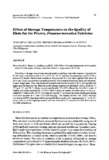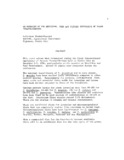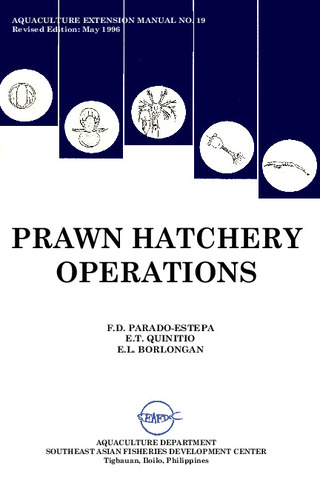Effect of storage temperature on the quality of diets for the prawn, Penaeus monodon Fabricius
- Global styles
- MLA
- Vancouver
- Elsevier - Harvard
- APA
- Help

View/Open
Date
1989Page views
3,548ASFA keyword
AGROVOC keyword
Taxonomic term
Metadata
Show full item recordCited times in Scopus
- Citations
- CrossRef - Citation Indexes: 1
- Policy Citation - Policy Citations: 2
- Scopus - Citation Indexes: 1
- Captures
- Mendeley - Readers: 15
Share
Abstract
The effect of storage temperature was evaluated on the basis of growth response of prawns fed for 10 weeks with diets stored at 0°C, 10°C, 28°C-31°C (ambient temperatures) and 40°C for a period of 10 weeks. Prawns were stocked at 15 pieces per 60-1 oval thank supplied with water at 28°C and 32 ppt in a flow-trough aerated system.There were five replicate tanks per treatment. Lowest weight gain (20 g) was observed for prawns fed the diet stored at 40°C and significantly higher growth response was observed as the storage temperature decreased (30.2g at 28-31°C; 37.7g at 0°C and 10°C). Body size was significantly (P<0.05) affected by diet after 6 weeks of feeding and highly significantly (P<0.01) after 8 weeks of culture.Peroxide values for diets exposed for 10 weeks to 28°-31°C (2.9 meq/kg). The highest survival rate (76%) and feed conversion (8.9%) were observed for prawns fed diets stored at low temperatures (0° or 10°C). Severe necrosis of the hepatopancreatic cells was observed in P. monodon fed with diet stored at the high temperature.
Suggested Citation
de la Cruz, M. C., Erazo, G., & Bautista, M. N. (1989). Effect of storage temperature on the quality of diets for the prawn, Penaeus monodon Fabricius. Aquaculture , 80(1-2), 87-95. https://doi.org/10.1016/0044-8486(89)90275-5
Type
ArticleISSN
0044-8486Collections
- Journal Articles [1249]
Related items
Showing items related by title, author, creator and subject.
-
An overview of the nutrition, feed and feeding techniques of prawn penaeid/shrimps
Piedad-Pascual, Felicitas (Philippine Council for Aquatic and Marine Research and Development, 1989)This paper echoes what transpired during the first International Conference of Penaeid Prawns/Shrimps held in Iloilo City in December 4-7, 1984, particularly on the Nutrition nd Feed Development. Around 25 papers were ... -
Series: Aquaculture extension manual; No. 19
Prawn hatchery operations
Parado-Estepa, Fe D.; Quinitio, Emilia T. ; Borlongan, Emeterio L. (Aquaculture Department, Southeast Asian Fisheries Development Center, 1996-05)
The manual, an updated version of the 1984 SEAFDEC/AQD manual, presents the underlying principles and step-by-step instructions of prawn larval and post-larval rearing. The techniques described are not only applicable to ...
; Borlongan, Emeterio L. (Aquaculture Department, Southeast Asian Fisheries Development Center, 1996-05)
The manual, an updated version of the 1984 SEAFDEC/AQD manual, presents the underlying principles and step-by-step instructions of prawn larval and post-larval rearing. The techniques described are not only applicable to ... -
The lowdown on world shrimp culture - II
Yap, Wilfredo G. (INFOFISH, 2001)This paper introduces some new members of the international shrimp culture club and goes on to discuss some recent technological innovations in the industry, particularly the polyculture of tilapia (mainly Oreochromis ...






